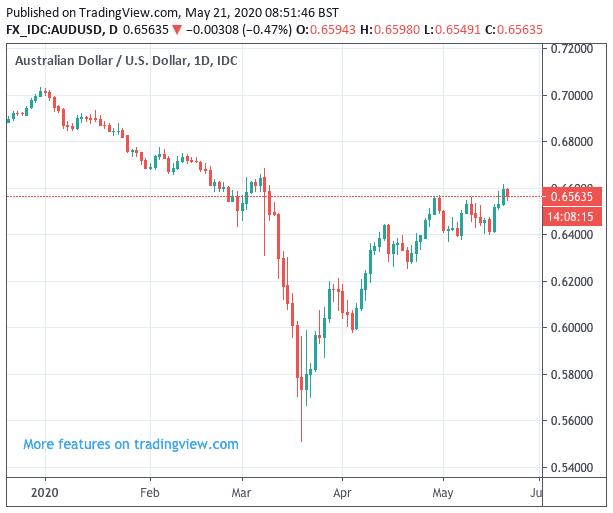Australian Dollar Forecast "to Turn Lower on a 1 to 3 Month View" by Rabobank, Citing Deterioration in China-Aussie Trade Relationship
- AUD continues a strong run
- But questions asked over sustainability of gains
- Rabobank forecast a multi-week decline looms
- Call comes as China looks to hit iron ore exports

Image © Adobe Stock
- GBP/AUD spot rate at time of writing: 1.8580
- Bank transfer rates (indicative guide): 1.7930-1.8060
- FX specialist rates (indicative guide): 1.8140-1.8400 >> more information
Foreign exchange strategists at Rabobank - the multi-national retail, commercial and investment bank - have said there is a chance the Australian Dollar's recent run of appreciation runs into trouble, leading to a decline over the course of the coming 1 to 3 months.
The Dutch-based bank see Australia's exposure to China as being key to the outlook for this currency, saying that while the recent recovery in global equity and commodity markets has proven supportive, rising trade tensions with the world's second-largest economy could prove problematic.
The call comes amidst a bout of Australian Dollar strength that has seen the headline Australian-U.S. Dollar exchange rate reach a multi-week peak of 0.6616 over the course of the past 24 hours, while the Pound-to-Australian Dollar exchange rate has fallen back to six-month lows at 1.8514.
The Australian stock exchange's main index - the ASX 200 - has rallied in sympathy with its global peers to reach its highest level since March, while commodity prices continue to stage a strong recovery: these developments provide a fundamentally supportive backdrop for the Aussie Dollar which is considered both a 'risk-on currency' and a 'commodity currency'.
However, Jane Foley, Senior FX Strategist at Rabobank, says the gains in the currency come at a time of souring relations between the U.S. and China which will lead to concerns over the growth rates of the world's second-largest economy.
Any impact to growth in China will in turn likely impact on demand for Australian exports, which would bode negative for the Aussie Dollar.
"Not only that but further signs of a worsening in the relationship between Canberra and Beijing are raising concerns that more Australian exports could be at risk from tariffs or other retaliation from China," says Foley.
Foley expects the AUD/USD 0.66 area to act as psychological resistance and look for AUD/USD to turn lower on a 1 to 3 month view as a result.
Australia has been a leading voice in calls for an independent investigation into the origins of the covid-19 epidemic, and specifically the Chinese state's handling of the early stages of the outbreak. China has in turn warned that Australian imports into the country would be jeopardised by Australia's calls for an investigation, and it appears China is now following through with its threats.
Media reports from the past 24 hours are not constructive on the matter of China-Australia trade relations, with news that China’s customs officials are set to impose new inspection procedures and rules on iron ore imports from next month.
Iron ore is Australia's main export and key foreign exchange earner, and it appears Chinese authorities are looking to add fresh lines of red tape around iron ore imports, which could be used to block or hold up Australian shipments.
"If coal or iron ore, Australia’s biggest export goods, were considered to be the subjects of Chinese retaliation, the risk to the country’s economy and to the AUD would be accentuated," says Foley.
A pattern is emerging: China earlier this month banned beef from three of Australia's main abattoirs, citing issues with standards. A tariff hike on barley came into effect earlier this week, with China citing the move was due to Australian government subsidies from the sector.
The game-plan therefore appears to be the use of technicalities and red tape to hit Australia, as opposed to pursuing a more blunt approach such as the diplomacy on trade deployed by U.S. President Donald Trump.
"Press reports suggest that China does not intend to publically acknowledge that there could be a link between actions taken on trade and Australian’s calls for a virus probe, but suspicions are
running high," says Foley.
A Bloomberg article out this week reported China is considering targeting more Australian exports including wine and dairy. Officials have drawn up a list of potential goods also including seafood, oatmeal and fruit that could be subject to stricter quality checks, anti-dumping probes, tariffs or customs delays, the report adds.
Foley adds that Sino-Aussie tension could come under further pressure as the U.S. is now making efforts to contain China’s standing as a military and a world power, which would possible see Australia come under more pressure to demonstrate its allegiances which could risk further retaliation on trade.
Rabobank are forecasting a dip towards 0.60 in AUD/USD in the run up to the U.S. Presidential election, a move that would in turn take some of the downside pressure off pairs such as GBP/AUD.






